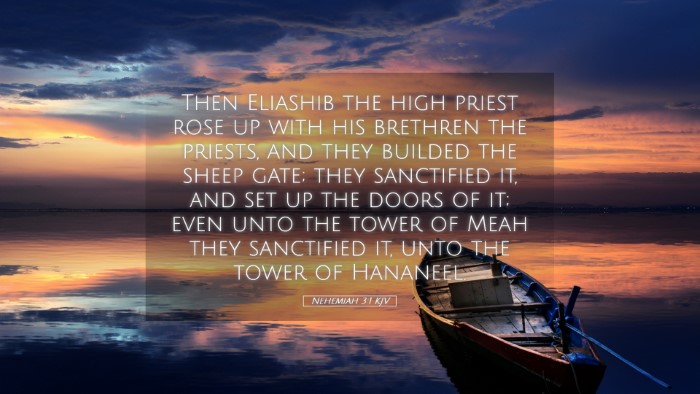Commentary on Nehemiah 3:1
Nehemiah 3:1 presents a pivotal moment in the narrative of the rebuilding of Jerusalem's walls. As we examine this verse in detail, we can draw from the insights of several esteemed public domain commentators, including Matthew Henry, Albert Barnes, and Adam Clarke. This commentary emphasizes the significance of community effort, leadership, and God's providence in the rebuilding process.
Verse Overview
Nehemiah 3:1 (KJV): "Then Eliashib the high priest rose up with his brethren the priests, and they builded the sheep gate; they sanctified it, and set up the doors of it; even unto the tower of Meah they sanctified it, unto the tower of Hananeel."
Historical Context
The historical backdrop of Nehemiah's narrative provides essential insight into the circumstances that prompted this massive rebuilding effort. After the Babylonian exile, the Israelites returned to Jerusalem to find the city in ruins, its walls and gates destroyed. Nehemiah, upon hearing of the distress of his people, was moved to take action. This verse marks the beginning of a collective effort toward restoration.
Insights from Matthew Henry
Henry emphasizes the role of Eliashib, the high priest, as a leader in this rebuilding project. He notes the significance of the sheep gate, which was crucial for the sacrificial system. According to Henry:
- Priestly Leadership: "The high priest's involvement highlights the importance of spiritual leadership in civic matters." A church's engagement in community restoration is essential.
- Symbolism of the Sheep Gate: "The sheep gate is where sacrifices were brought, symbolizing both physical and spiritual renewal." Thus, the rebuilding signifies a community returning to right worship.
- Sanctification Process: "They sanctified the gate, which signifies setting it apart for holy use—illustrating the need for holiness in all endeavors." Leadership must call for the sanctification of their work to honor God.
Insights from Albert Barnes
In his commentary, Barnes provides a thorough examination of the construction process described in this verse. He notes:
- Community Involvement: "The involvement of various priests signifies that rebuilding was a communal effort rather than solely the responsibility of a few." This serves as an encouraging model for modern church communities.
- Importance of Structure: "The mention of specific towers, like the tower of Meah and the tower of Hananeel, indicates meticulous planning in the work of construction." Accurate architectural references denote thoughtful care in the restoration undertaken.
- Spiritual Restoration: "The act of building the gate and sanctifying it symbolizes spiritual renewal, an analogy for churches today concerning outreach and engagement." Rebuilding community and focus on mission is vital in today’s context.
Insights from Adam Clarke
Clarke’s commentary focuses on the theological aspects of the activities depicted in Nehemiah 3:1. His reflections include:
- The Sheep Gate's Theological Significance: "This gate represents Christ, the Lamb of God—an initial focus for the community's return to worship after exile." Clarke articulates that understanding our foundations in Christ is crucial.
- Role of Sacred Spaces: "Setting apart spaces for worship emphasizes God's presence among His people." Clarke encourages present-day believers to recognize the sacredness of their gathering places.
- An Encouragement to Unity: "The work done aligns the physical rebuilding with the unity of believers under the leadership of God." He invites churches to recognize their mission as collaborative and inclusive.
Theological Implications
Through these commentators, we can extract even deeper theological implications from Nehemiah 3:1:
- Leadership and Sacrifice: Effective leadership, particularly from spiritual leaders, plays a vital role in guiding communities toward restoration. Their actions inspire others to join the effort.
- Community Restoration: Nehemiah’s initiative underlines the necessity of collective action. Restoring a community requires diverse participation across all demographics.
- The Central Role of Christ: The allegorical interpretation of the sheep gate reminds contemporary Christians of the foundational role of Christ in their mission, emphasizing the need for spiritual alignment.
- Sanctification of Efforts: The idea of sanctifying work applies today as believers seek to honor God in all endeavors, turning mundane tasks into acts of worship and dedication.
Application for Modern Believers
For pastors, theologians, and students of Scripture, Nehemiah 3:1 serves as a reminder of the importance of community, leadership in spiritual matters, and the need for sanctification in efforts to serve God. Key applications include:
- Recognizing the call to community involvement in church restoration and outreach initiatives.
- Understanding the theological implications of sacred spaces as they relate to worship today.
- Promoting collaboration and unity in mission work, ensuring all voices within the community are heard and valued.
- Encouraging a spirit of holiness in all endeavors, seeking to honor God in both organizational and individual tasks.
Conclusion
Nehemiah 3:1 encapsulates the essence of communal restoration through leadership, spirituality, and a focus on holiness. The insights drawn from the works of Henry, Barnes, and Clarke provide a comprehensive understanding that modern believers can apply. As we reflect on this passage, we are prompted to consider how we can contribute to the rebuilding efforts within our communities, both physically and spiritually, recognizing the ultimate foundation is Christ as our Shepherd and sacrificial Lamb.


